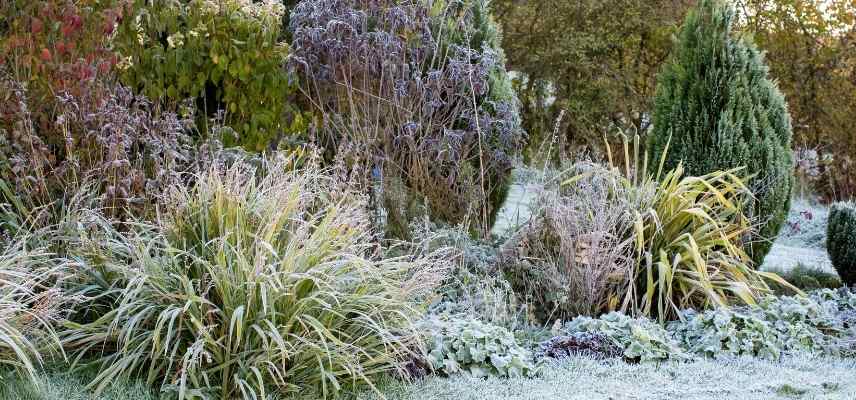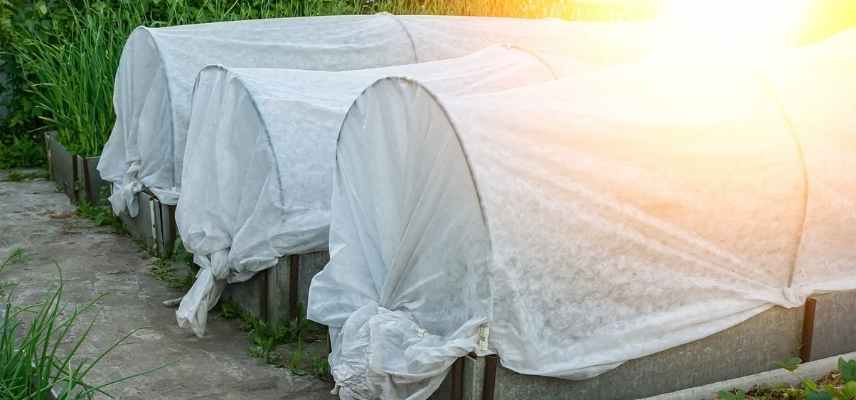
Late frosts, cold spring: what to do in the garden?
We're waiting for the thaw...
Contents
Spring can sometimes turn out to be cold, even very cold. It is not uncommon to experience late frost episodes during April (the red moon) or May (the ice saints). Unfortunately, this is also the time when plants choose to restart their growth or to flower. In most cases, everything goes relatively well. But when the frost lasts longer and temperatures drop very low, it can cause quite a bit of damage to trees, bushes, perennials, young plants in the vegetable garden, and of course to more tender plants. What can be done to prevent this? How should one react when a plant seems to have completely frozen?
Let's distinguish between white frost and black frost!
Cold in spring is not always synonymous with destruction in the garden. A few white frosts in the morning do not cause (too much) harm. However, damage can quickly occur if the frost is stronger and lasts longer. Let’s distinguish between the two types of frost:
- White frost: it appears at the end of the night or at dawn. Essentially, the cold air, being heavier than warm air, descends to the ground at night. This phenomenon is regular at the end of winter and the beginning of spring. White frost is rarely problematic, as it lasts only a few hours and occurs at temperatures just slightly below 0 °C. This type of frost does not penetrate deeply into the tissues, so the damage is limited.
- Black frost: now that’s a real problem! The temperature will drop lower, often below -5 °C and for a longer duration: an entire night or sometimes several consecutive days. The frost penetrates the tissues and causes the cells to burst. The fragile parts of the plants (young shoots, young buds, flower buds…) are irreparably burned. It will take several weeks for the plant’s latent buds to start before considering any further action.
 Frost becomes problematic when it is severe and lasts for a long time.
Frost becomes problematic when it is severe and lasts for a long time.
We anticipate!
In the Garden
- Apply a good mulch around the base of the most delicate plants: dead leaves, straw, chippings, or even cardboard—anything will do to protect the roots of plants sensitive to cold;
- Hill up the plantings: for young sowings or potatoes, the soil acts as a thermal insulator;
- Bring in pots and planters: plants that may suffer from late frost should be moved to a cool place (between 5 and 10 °C), but sheltered from frost, bright, and well-ventilated. An unheated conservatory, a sufficiently bright garage…
- Place glass cloches (or plastic ones if necessary) over young shoots in the vegetable garden;
- A winter cover can save the day: over the first sowings in the vegetable garden with a forcing film and to completely cover the most fragile plants with a winter cover or a winter cover that can “gain” a few degrees (2 or 3 °C maximum). Although breathable and air-permeable, these non-woven covers should be removed as soon as temperatures rise. Therefore, place them in the evening and remove them in the morning;
- Be cautious with watering: stagnant water in the soil, especially in poorly drained areas, wreaks havoc once frozen and destroys plant roots. If you need to water, do so in the morning when temperatures are milder (at least 3 or 4 °C). The water will have time to penetrate the soil or substrate before the next frost. But otherwise, completely avoid watering when frost is likely! Please note: Here’s a little tip from Nordic countries (sometimes used by fruit producers): a fine mist of water can prevent frost damage due to the heat released by the droplets as they cool and freeze. It’s an idea to test on a few potted plants, for example;
- Avoid planting species unsuitable for the garden’s climate and soil: “the right plant in the right place“. There’s no point in trying to grow a frost-sensitive perennial in the mountains or a Mediterranean bush in the North. The soil also significantly impacts plant hardiness: a tender perennial will fare better in well-drained soil than in soil that retains water in winter. → If in doubt, don’t hesitate to consult PlantFit, the app that helps you plant appropriately.
- Choose late-developing perennials or trees and bushes that bud late in the season. This way, you’ll avoid many frost-related issues.
 Winter covers are essential!
Winter covers are essential!
In the Cultivations
- Heaters, heat mats, and candles: this is mainly reserved for crops (fruit trees, vines…), but in some cases, especially during flowering, producers use heat cannons, heat mats, or large candles placed between plants or trees to raise the temperature slightly;
- Spraying hot water or steam in viticulture;
- Water spraying: this may seem paradoxical, but a small amount of frozen water on flower buds provides thermal insulation for them. However, this is a delicate technique reserved for professionals.
 Water spraying helps protect flower buds
Water spraying helps protect flower buds
Let's calm down and think!
When you spot the first signs of frost damage on your perennials, trees, and bushes, it is essential to stay calm and do nothing (and this urgently!). Patience is a gardener’s friend, and even though it may be tempting to quickly cut back the burnt parts, it is better to leave them alone. In any case, not until the plants show new signs of life.
Read also
8 very hardy shrubs resistant to frostWe're stepping in!
After a few days following the frost, the affected parts of the perennials have dried out. You can then trim them back with pruning shears or shears and wait for the new shoots to emerge. Water well and add compost at the base of your perennials to help them recover more quickly.
After several weeks, the latent buds of trees, bushes, and woody climbers will grow in place of the now dead main buds. The new shoots and foliage will develop rapidly. You will then only be able to trim back the dead and dry parts, which will be clearly visible this time.
For the vegetable garden and annuals, if the young shoots have been burnt by the frost, they are definitely dead. It is then advisable to replant other young plants or to proceed with a new sowing.
 Frost on a Magnolia’s flowering
Frost on a Magnolia’s flowering
- Subscribe!
- Contents
































Comments